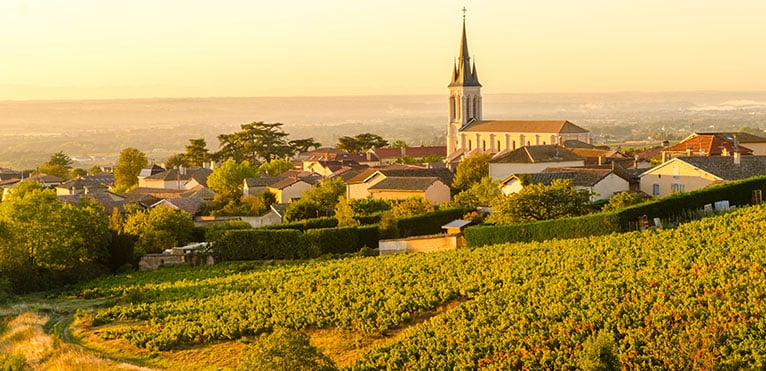
Contents
Chénas is an AOC appellation for a red wine produced in the Beaujolais region. More precisely, it is grown astride the Saône-et-Loire and Rhône departments, in the communes of Chénas and La Chapelle-de-Guinchay. Its terroir borders the Moulin-à-Vent appellation to the south, the Juliénas appellation to the northwest and the Saint-Amour appellation to the north.
The winegrowing tradition of AOC Chénas goes back to antiquity
The tradition of winegrowing in Chénas is linked to the region and probably dates back to Gallo-Roman times. If the origin of the word Chénas is lost in history, the two most likely theories are that it derives from the Gallic word “Cassanus”, meaning oak, or from the name of a Roman nobleman who settled in the region, a certain Canus.
Throughout its history, the Chénas vineyard has been influenced by the broader development of viticulture in the Beaujolais region. The latter is particularly marked by the actions of the monks of the Abbey of Cluny and their collaboration with the local lords. The presence of wine merchants’ towns in the region, such as Mâcon and Villefranche-sur-Saône, means that Beaujolais wines like Chénas have access to commercial outlets. In the 17th century, Chénas acquired a certain renown thanks to the royal power when Louis XIII made it his favorite wine.
It was in the middle of the 20th century that the Beaujolais vineyards gained greater renown. Starting in 1951, the release of Beaujolais Nouveau gradually established itself as a key event in the month of November. The entire wine-growing region benefits from these spin-offs. As for Chénas, it is developing and maintaining its reputation as one of the most sought-after crus in Beaujolais.
The terroir of AOC Chénas is located on the banks of the Saône.
Chénas is a red wine, AOC, cultivated on 250 hectares between La Chapelle-de-Guinchay and Chénason the right bank of the Saône. Vines are grown here thanks to an oceanic climate with continental trends, as well as the southeast-facing slopes of the Monts du Beaujolais.
The quality of the soil, a mixture of granite and rich silty deposits drained by the Saône, is a major factor. This produces a high-quality wine, but in limited quantities, due to the characteristics of this rich, sandy soil.
Chénas is a wine of character
The grape variety used to produce Chénas, as in the rest of Beaujolais, is Gamay Noir with white juice. This produces a wine with the purplish-red color characteristic of this region’s crus. As it ages, its color tends to take on a garnet-tinged ruby.
On the nose, Chénas is full-bodied and woody, with floral notes of rose and, above all, peony. It gives off a spicy, vanilla fragrance, the fruit of the oak casks in which it has been stored.
Its attack on the palate is clean and frank. Its acidity is not very pronounced. The tannins support, without masking, its fleshy, fruity character, which develops before giving way to a fresher finish.
Chénas can generally be kept for 4 to 8 years.
AOC Chénas is marked by its terroir
Although Chénas is a full-bodied, robust wine, it tends to soften with age, becoming softer and silkier. It’s a good companion for local specialties, and goes wonderfully with a Lyonnais brioche sausage or Bresse poultry. Served between 14 and 15°C, it’s also an excellent accompaniment to veal-based dishes: whether filet mignon, côtes parmentières or, of course, blanquette.
A recent history but many fine vintages for the Chénas vineyard
Over the course of its history, Chénas has seen many exceptional vintages. While 1928, 1934, 1937, 1966 and 2011 are considered great years, bottles produced in 1949, 1952, 1969 and 2005 are considered vintages of the century. Finally, 1929, 1945, 1959 and 2009 are particularly exceptional, to the point of being designated as millennium vintages.
Chénas is a family terroir made up of independent winegrowers.
Pascal Aufranc Estate
An independent winegrower in Chénas, Pascal Aufranc cultivates a 9-hectare estate perched on the hill “En Remont”, producing Chénas and Juliénas appellation wines.
The estate, a converted farmhouse, is also the winemaker’s home. He produces his wines using a “culture raisonnée” method that is as respectful as possible of the environment. We recommend tasting the “Chénas Vignes de 1939”, the fruit of an 80-year-old parcel of vines.
Domaine Bulliat
A family estate run by Noël Bulliat and his son Loïc, it covers 28 hectares in various appellations in the heart of the Beaujolais region. In 2010, they decided to convert their entire estate to organic farming, using natural products to fight pests and diseases, as well as grass cover.
This commitment is also reflected in our pruning and harvesting practices: careful hand-picking to select only the finest grapes. The wines are aged in temperature-controlled stainless steel vats, as well as in barrels for certain cuvées. The estate offers a wide range of wines from Beaujolais Nouveau to Chénas not forgetting Morgon and Crémant.